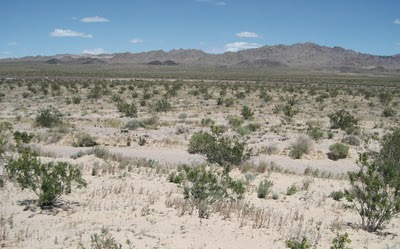Calico and Ridgecrest Solar Projects Haunt Pristine Desert
Two different solar companies--Solar Millennium LLC and K Road Power--have officially revived proposals to build solar power projects on public land in the Mojave Desert. Both projects have been heavily criticized by biologists and taxpayers (and some biologists that pay taxes) as a waste of money and public land.
K Road Power must also track two separate legal challenges against the State of California and the Federal Government challenging the approval of the project. The Sierra Club filed a lawsuit challenging California's rushed approval of the project without fully considering the impact on wildlife and the effectiveness of mitigation measures. The second legal challenge was filed by a coalition of Native Americans and concerned citizens against the Department of Interior's decision to allow the Calico project to destroy over 7 square miles of pristine public land without fully considering impacts on sites of historical significance to Native American tribes and the cumulative ecological damage.
The DRECP is in the process of identifying lands that may be suitable for solar energy development, and other lands that should be set aside for conservation. Solar Milllennium LLC is likely hoping that the DRECP will identify lands in the vicinity of its originally proposed project as suitable for development, giving it hope that it can build the project. However, the CEC proceedings indicate that biologists have identified the Ridgecrest site as a wildlife corridor for the Mohave ground squirrel, which is under consideration for endangered species protections. The site also hosts an unusually high density of desert tortoises. At least 40 desert tortoises were observed on the site during surveys.
Calico Solar Project
K Road Power (and its subsidiary K Road Solar) filed a petition with the California Energy Commission (CEC) on 22 March to modify the original Calico Solar power project, that was approved by the CEC last year. The company that initially proposed and won approval for the Calico Solar power project--Tessera Solar LLC--could not afford to build the project, and sold the rights to public land to K Road Power. That company is now proposing slight changes to the original proposal, calling for a mix of photovoltaic panels and the "Suncatcher" design. Because K Road Solar is changing the original design, they should have to submit to a new environmental review process because photovoltaic panels will alter water flows and landscape in different ways than the original Suncatcher dishes.K Road Power must also track two separate legal challenges against the State of California and the Federal Government challenging the approval of the project. The Sierra Club filed a lawsuit challenging California's rushed approval of the project without fully considering the impact on wildlife and the effectiveness of mitigation measures. The second legal challenge was filed by a coalition of Native Americans and concerned citizens against the Department of Interior's decision to allow the Calico project to destroy over 7 square miles of pristine public land without fully considering impacts on sites of historical significance to Native American tribes and the cumulative ecological damage.
Ridgecrest Solar Power Project
On 24 March, Solar Millennium LLC submitted a petition to the CEC asking to temporarily suspend consideration of the Ridgecrest Solar power project until the company can evaluate the outcome of the Desert Renewable Energy Conservation Plan (DRECP) for opportunities to build the project. The company previously abandoned the project because even the CEC staff indicated that the project would destroy over 6 square miles of public land that hosts thriving populations and corridors for the threatened desert tortoise and Mohave ground squirrel. The DRECP is in the process of identifying lands that may be suitable for solar energy development, and other lands that should be set aside for conservation. Solar Milllennium LLC is likely hoping that the DRECP will identify lands in the vicinity of its originally proposed project as suitable for development, giving it hope that it can build the project. However, the CEC proceedings indicate that biologists have identified the Ridgecrest site as a wildlife corridor for the Mohave ground squirrel, which is under consideration for endangered species protections. The site also hosts an unusually high density of desert tortoises. At least 40 desert tortoises were observed on the site during surveys.





Comments
Post a Comment